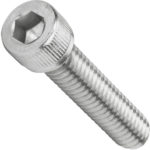Socket Sizes in Order From Smallest to Largest
Sorting socket by sizes in order from smallest to largest is not as simple as one might think. First, you need to know which size of the drive you are using.
Most common dive sizes are:
- 1/4″ drive
- 3/8″ drive
- 1/2″ drive
- other drive sizes
Also, there are 2 main measurement standards:
- Metric
- SAE

Here are a couple of review articles we did on socket sets:
7 Best Socket Sets For the Money Review
11 Best Socket Organizer Review
You may already own some socket or a set. Most likely, you are missing one or more sizes, and you need to get them to complete the set. Just down below, you will find reference charts so you can quickly find out which socket sizes you are missing. They are also sorted by size, from smallest to largest.
Pro Tip: Don’t expect any set to have absolutely all sizes from the chart list, and you will never need all of them. So, consider your tooling needs first to determine which sizes you need to be present in the socket set.
You can download a PDF version of the tables here.
Metric Socket Sizes Chart
| 1/4" Drive | 3/8" Drive | 1/2" Drive | 3/4" Drive | 1" Drive |
|---|---|---|---|---|
| 4mm | 5.5mm | 8mm | 19mm | 36mm |
| 4.5mm | 6mm | 9mm | 20mm | 38mm |
| 5mm | 7mm | 10mm | 21mm | 41mm |
| 5.5mm | 8mm | 11mm | 22mm | 46mm |
| 6mm | 9mm | 12mm | 23mm | 50mm |
| 7mm | 10mm | 13mm | 24mm | 54mm |
| 8mm | 11mm | 14mm | 25mm | 55mm |
| 9mm | 12mm | 15mm | 26mm | 58mm |
| 10mm | 13mm | 16mm | 27mm | 60mm |
| 11mm | 14mm | 17mm | 28mm | 63mm |
| 12mm | 15mm | 18mm | 29mm | 65mm |
| 13mm | 16mm | 19mm | 30mm | 67mm |
| 14mm | 17mm | 20mm | 31mm | 70mm |
| 15mm | 18mm | 21mm | 32mm | 71mm |
| 19mm | 22mm | 33mm | 75mm | |
| 20mm | 23mm | 34mm | 77mm | |
| 21mm | 24mm | 35mm | 80mm | |
| 22mm | 25mm | 36mm | ||
| 26mm | 38mm | |||
| 27mm | 40mm | |||
| 28mm | 41mm | |||
| 30mm | 42mm |
SAE Socket Sizes Chart
| 1/4" Drive | 3/8" Drive | 1/2" Drive | 3/4" Drive | 1" Drive |
|---|---|---|---|---|
| 5/32" | 1/4" | 3/8" | 7/8" | 1-5/8" |
| 3/16" | 5/16" | 7/16" | 15/16" | 1-11/16" |
| 7/32" | 3/8" | 1/2" | 1" | 1-3/4" |
| 1/4" | 7/16" | 9/16" | 1-1/16" | 1-13/16" |
| 9/32" | 1/2" | 19/32" | 1-1/8" | 1-7/8" |
| 5/16" | 9/16" | 5/8" | 1-3/16" | 2" |
| 11/32" | 5/8" | 21/32" | 1-1/4" | 2-1/8" |
| 3/8" | 11/16" | 11/16" | 1-5/16" | 2-3/16" |
| 7/16" | 3/4" | 3/4" | 1-3/8" | 2-1/4" |
| 1/2" | 13/16" | 25/32" | 1-7/16" | 2-3/8" |
| 9/16" | 7/8" | 13/16" | 1-1/2" | 2-1/2" |
| 15/16" | 7/8" | 1-5/8" | 2-5/8" | |
| 1" | 15/16" | 1-11/16" | 2-3/4" | |
| 1" | 1-3/4" | 2-15/16" | ||
| 1-1/16" | 1-13/16" | 3" | ||
| 1-1/8" | 1-7/8" | 3-1/8" | ||
| 1-3/16" | 2" | |||
| 1-1/4" | 2-1/8" | |||
| 1-1/2" | 2-3/16" | |||
| 2-1/4" |
SAE to Metric Conversion Chart
In this world where dual standards in engineering coexist together, you will often find yourself having a bolt or a nut and will not know which exact socket size or wrench to use. If you, for example, have a nut with a 5/16″ (ANSI or Imperial units), and you have a wrench in metric units, you will have to use an 8mm wrench to tighten it. This is what the SAE to Metric conversion char shows.
| SAE Size | Metric Size | Inches Decimal | |
|---|---|---|---|
| 5/32" | 0.156 | 5/32" and 4mm are | |
| 4mm | 0.157 | close enough | |
| 4.5mm | 0.177 | ||
| 3/16" | 0.188 | ||
| 5mm | 0.197 | ||
| 5.5mm | 0.216 | ||
| 7/32" | 0.219 | ||
| 6mm | 0.236 | ||
| 1/4" | 0.25 | ||
| 6.5mm | 0.256 | ||
| 7mm | 0.276 | ||
| 9/32" | 0.281 | ||
| 5/16" | 0.313 | 5/16" and 8mm are | |
| 8mm | 0.315 | close enough | |
| 11/32" | 0.344 | ||
| 9mm | 0.354 | ||
| 3/8" | 0.375 | ||
| 10mm | 0.394 | ||
| 13/32" | 0.406 | ||
| 11mm | 0.433 | 7/16" and 11mm are | |
| 7/16" | 0.438 | close enough | |
| 15/32" | 0.469 | 15/32" and 12mm are | |
| 12mm | 0.472 | close enough | |
| 1/2" | 0.5 | ||
| 13mm | 0.512 | ||
| 17/32" | 0.531 | ||
| 14mm | 0.551 | ||
| 9/16" | 0.563 | ||
| 15mm | 0.591 | 19/32" and 15mm are | |
| 19/32" | 0.594 | close enough | |
| 5/8" | 0.625 | ||
| 16mm | 0.63 | ||
| 21/32" | 0.656 | ||
| 17mm | 0.669 | ||
| 11/16" | 0.688 | ||
| 18mm | 0.709 | ||
| 23/32" | 0.719 | ||
| 19mm | 0.748 | 3/4" and 19mm are | |
| 3/4" | 0.75 | close enough | |
| 25/32" | 0.781 | ||
| 20mm | 0.787 | ||
| 13/16" | 0.813 | ||
| 21mm | 0.827 | ||
| 27/32" | 0.844 | ||
| 22mm | 0.866 | ||
| 7/8" | 0.875 | ||
| 23mm | 0.906 | 29/32" and 23mm are | |
| 29/32" | 0.906 | close enough | |
| 15/16" | 0.938 | ||
| 24mm | 0.945 | ||
| 1" | 1 |
Drive Sizes
The drive size on a ratchet (aka: socket wrench) is the small square connection fitting at the end of the ratchet. This fitting accepts sockets of the same size. There are 3 common ratchet drive sizes used in shops and home garages, but other drive sizes also exist.
1/4″ Drive
Used for low torque, precision, or interior work. Usually, you want to use with a socket size 12mm or smaller (but up to 14mm for low torque applications).
3/8″ Drive
The most versatile and useful drive size for most people. Use it for engine work or all-purpose use around your home. It allows you to apply quite a bit of torque yet fits in spots that a 1/2″ drive won’t. Generally, you’ll want to use 12mm to 18mm sockets (or larger if the torque won’t be too high).
1/2″ Drive
Used for instances where a lot of torque is required, such as a car’s lug nuts or exhaust system or if driving large lag bolts into your wall studs to install a flat-screen TV. Generally used for 19mm and larger sockets or impact sockets.
Here is the video that further, and in detail, explains about different types of ratchets and sockets:
Other Socket Drive Sizes
While most individuals will never need anything other than the three drive sizes above, ratchets with 3/4″, 1″, 1-1/2″, and larger drive sizes do exist. These are most often used for industrial applications or on vehicles such as large trucks, tractors, and tanks.
Once you have handled the socket sizes, consider pairing them with one of the best socket organizers to have every socket stored in an appropriate place.






